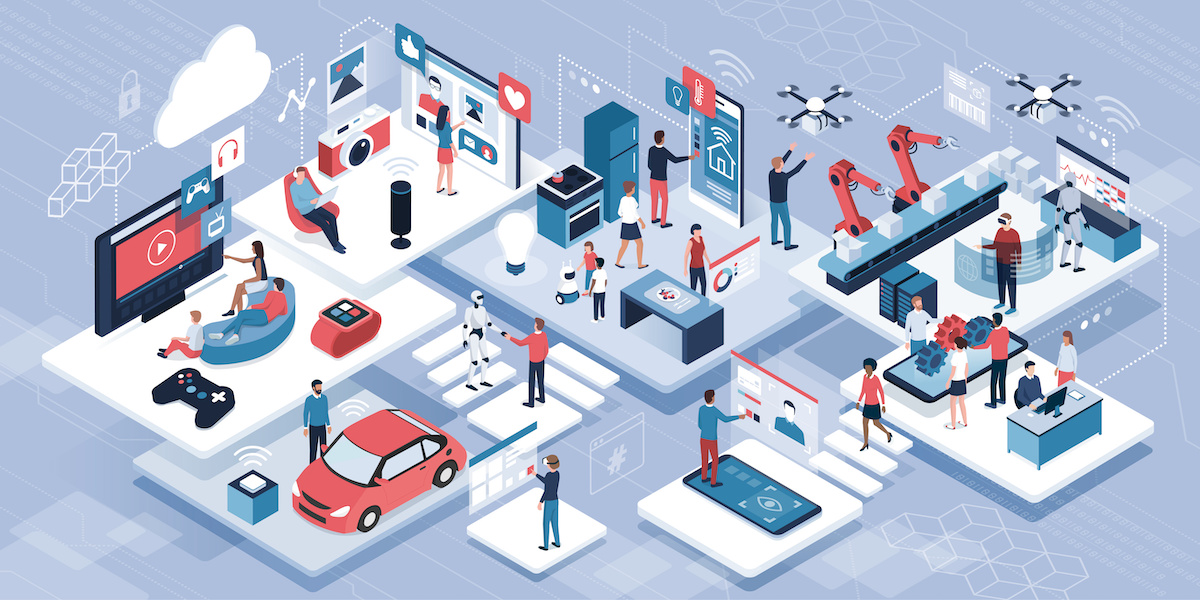5 Important Technologies Made Possible by Data Centers17 min read

The digital revolution is here. Nearly every industry, platform, and experience have some kind of digital component. With every one of those digital interactions or processes comes a stream of data.
All of that data must flow somewhere. That’s precisely where data centers come into the picture. They are a collection of servers meant to house, process, and transmit massive troves of data. Cloud computing is, in essence, powered by various data centers all over the world.
Without data centers, there are many technologies and modern solutions that just wouldn’t be possible. For example, Software-as-a-Service (SaaS) would not be available without remote servers hosting the platforms, and a data center housing the servers. Of course, this is just one of many examples.
Here are some of today’s technologies made possible by data centers.
1. Internet of Things (IoT)
The Internet of Things brings a network connection to devices that never had one before, such as lighting, smart switches, equipment, and appliances. It allows for smarter and more efficient use of various devices and platforms. Lights, for example, can be automated or controlled via voice commands.
But IoT wouldn’t be possible without an active data connection, or the information being collected and processed. It’s all sent to remote servers, which are housed within a data center. Most of the processing and analytics do not happen on the device itself because a small, internet-enabled device, like a smart switch or bulb, doesn’t generally have the processing power to do so.
Instead, it’s transmitted to a data center. The information is then returned to the devices, so they can take action or otherwise. That information is also generally served to a mobile application, which users can tap into.
2. Vaccine Research
Cloud computing, empowered by data centers and remote processing, has significantly improved the capabilities of health care centers, including research facilities. Often held back by outdated or less-powerful IT infrastructure, these facilities can instead rely on remote operations with more scalability, enhanced processing power, better security, and greater interoperability through shared data.
So, projects like viral research can be conducted at unprecedented rates through modeling tools, testing, and data-sharing, and it can all be done across various departments or locations.
For instance, biological and specimen data can be shared openly between research facilities, which speeds up many of the initial data collection processes. Patient demographics, medical conditions, medications, and medical procedures can all be customized to find the right specimens, which are then used in testing and research to do things like discovering a working vaccine or cure.
3. eLearning
Amid the pandemic, everyone has gone remote, including students. They are now attending classes online via platforms like Zoom, Lark, and other teacher-assisting programs. Again, none of this would be possible without data centers behind the scenes.
Data centers empower the remote conferencing tools, as well as the educational data being sent between parties, whether that’s school homework, research, or visual content.
Let’s consider a simple piece of online homework, for example. A teacher either creates or sources the information used for the homework and sends the assignment via one of the remote platforms. It uploads to a data center, where it remains so students can access and download the content. They work on the assignment locally and then upload it to the servers as a finished project.
The instructor can then download those finished assignments, grade them, and either deliver a grade or re-upload the graded piece. All of that back and forth requires a middleman, which is the data center where the information is housed.
4. Social Media
No social media networks would exist without data centers and cloud computing technologies to support them. The cloud serves as the backbone or foundation for each of these platforms. Every profile, post, and interaction is stored and even carried out through big data.
Whether browsing on a mobile device or a desktop computer, users’ interactions are sent to the remote servers: the social network’s data center.
Back in 2020, Facebook committed to developing a new $800 million data center in DeKalb, Illinois, and another in Gallatin, Tennesee, which will be its 12th and 13th data centers in the country, respectively. That’s just Facebook! Imagine how many data centers the other networks have, including Twitter, TikTok, Instagram, and more.
5. Machine Learning and AI
From simpler, consumer-grade platforms like Alexa or Siri to more advanced solutions such as IBM’s Watson, machine learning and AI technologies require access to big data. All of that information is housed and processed within data centers.
An AI assistant like Alexa wouldn’t be possible without Amazon’s servers behind it. It all relies on huge stores of information about user behavior, shopping history, preferences, and more to react and make suggestions to customers. Alexa always knows what people add to their shopping cart and what they’ve purchased recently.
That’s because all of their Amazon data is connected, from the shows they watch to the music they listen to and the products they regularly purchase. This same kind of data is collected and leveraged for nearly all AI solutions.
Machine learning platforms, especially those used to research, can process and analyze huge stores of information to find trends or patterns the untrained eye couldn’t. That information would not be available if kept locally because it would take up way too much physical space.
Data Centers Are Critical to the Digital World
Without data centers and cloud computing, many of the technologies discussed here would not be possible. But they are not the only ones. Modern logistics, health care portals, mobile applications, telecommunications, and many other technologies rely on access to remote computing and data tools.
Digital solutions of any kind just would not function without data centers as the backbone. Clearly, the world needs data centers and data center expertise to power our digital experiences and lives.
Real-time monitoring, data-driven optimization.
Immersive software, innovative sensors and expert thermal services to monitor,
manage, and maximize the power and cooling infrastructure for critical
data center environments.
Real-time monitoring, data-driven optimization.
Immersive software, innovative sensors and expert thermal services to monitor, manage, and maximize the power and cooling infrastructure for critical data center environments.

Devin Partida
Editor-in-Chief at ReHack
Devin Partida writes about data, cybersecurity and smart tech for ReHack.com, where she is also the Editor-in-Chief.
0 Comments